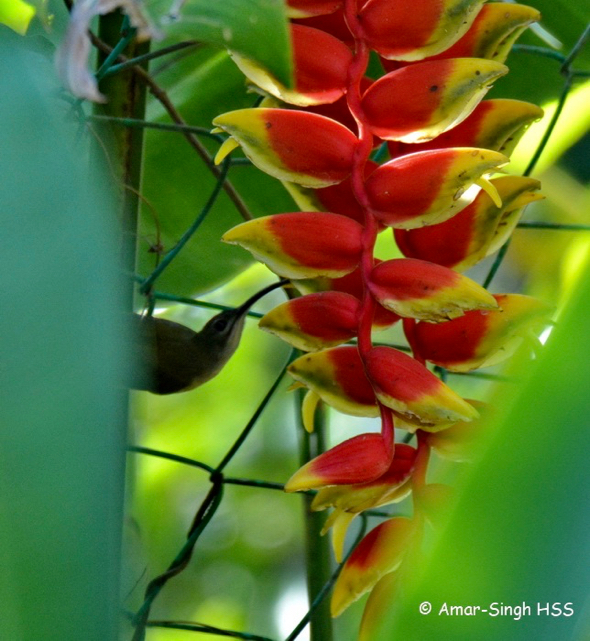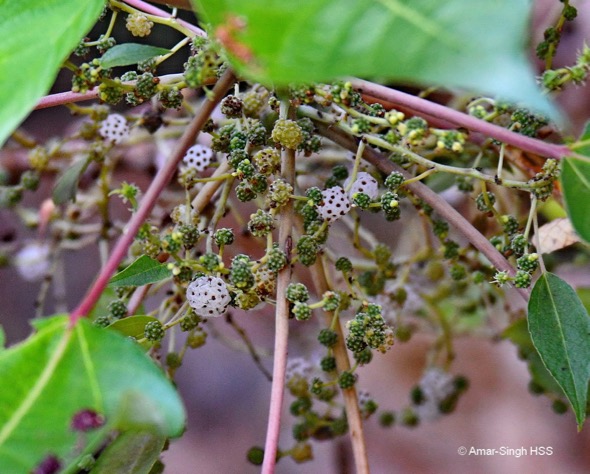“If you want to attract birds to your garden, make sure that the environment can support the bird population. In other words, your home must be a place where birds can find a decent living.
“I am not about to go into the legalities of whether or not feeding birds within your own house will get you into trouble with the authorities in Singapore, but in Europe and America, many bird watchers do feed.
“If you are not in Singapore, and you decide to feed, make sure that you do it regularly and conscientiously. You cannot build up a population of birds to a heavy density in a neighbourhood, then go on a long vacation, and leave them to starve to death.
“If you want them to spread out to fend for themselves, you will have to cut down the food rations gradually, not suddenly.

“That said, in my house, a lot of natural food is provided for the birds. My lawn is mowed at slightly longer intervals than normal, allowing grass to produce some seeds.
“In addition to the normal cow grass (Axonopus compressus) and buffalo grasses (Paspalum conjugatum), I sow a lot of white millet [White Millet (Panicum miliaceum) is a popular ingredient in many birdseed mixes. Pure white millet is available at Amazon.com]. This sprouts readily. The young shoots are eaten by doves, rails, waterhens and crakes.
“Other permanent features that attract birds are my series of small ponds and the selective planting of bird-friendly trees.
“There are more than 10 water containers dotted around my garden, of the sort which I have described in earlier articles on this website on how to attract kingfishers to a suburban garden, and how to build bird-friendly water features. Without the provision of additional feeding, these water containers generate sufficient baby fish, tadpoles, water snails and edible water weeds to attract kingfishers, White-breasted Waterhens (Amaurornis phoenicurus), Little Herons (Butorides striatus) and the occasional Slaty-breasted Rail (Gallirallus striatus) or Ruddy-breasted Crake (Porzana fusca).

“There is also plenty of planting of torch gingers (Etlingera elatior), calatheas (Calathea spp.) and heliconias (Heliconia spp.) to provide cover for these wading birds. Within the water are plenty of water canna (Thallia spp.) which not only provide cover for the wading birds but are also favourite nectar sources for sunbirds.

“In the more open parts of the garden I plant a hedge of hibiscus for the sunbirds.
“Next to my porch, and surrounding my garden pavilion are orange jasmine (Murraya paniculata) and water jasmine (Wrightia religiosa) bushes in pots. These provide scent and nectar for the sunbirds and Yellow-vented Bulbuls (Pycnonotus goiavier) eat the orange jasmine fruits.

People may consider sendudok (Melastoma malabathircum) or Straits Rhododendron to be a weed. I think that it has attractive flowers, and produces berries that bring lots of birds. There is a row of these plants in my back garden, and I fertilise and water them regularly to encourage fruiting.
“By accident, Australian mulberry trees (Pipturus argenteus) have sprouted in both my house and that of my neighbour, also a bird lover. When these fruit, birds come in droves, especially glossy starlings LINK.

“I am fortunate enough to have moved into a house with a mature weeping fig (Ficus benjamina) in the garden. There is an even bigger one just across the road. Both these trees attract lots of birds, not only for the fruits on the trees, but for those fallen on the ground too. Spotted Doves (Stigmatopelia chinensis) and Zebra Doves (Geopelia striata) pick up the fallen fruit, and even Oriental Magpie-robins (Copsychus saularis) come around to hunt the insects which the fruits attract.

“My bird-loving neighbour does not object to the koel, parakeets, orioles and many other birds that raid her rambutan and chiku trees. Though these trees are not in my garden proper, some of their branches overhang our fence, and I get to see all the avian visitors.”
Lee Chiu San
Singapore
31st March 2018
This article first appeared as a “comment” to the 16th June 2014 post Half-baked birds and other animals.









2 Responses
Unlike in Europe and America bird feeders do not seem to attract birds to great extent in tropical countries and are not very popular. Is it because adequate natural food is available in abundance for birds to feed? I noticed many stores in USA have separate sections for bird feeders and specialized feeders even for humming birds, woodpeckers, etc. are available.
I wonder whether people in the tropics feed birds during winter when food is scarce or the whole year round?